Age of the Tuchengzi Formation in Western Liaoning Province and the Jurassic–Cretaceous Boundary from the Continuous Core Records of Well YD1, Jinyang Basin
Abstract
:1. Introduction
2. Recent Advances in the Study of the Jurassic-Cretaceous Boundary
2.1. Advances of the Global Marine Jurassic-Cretaceous Boundary
2.2. Recent Advances in the Terrestrial Jurassic-Cretaceous Boundary in the Jibei-Liaoxi Region
2.2.1. The Time Limit of the Terrestrial Jurassic-Cretaceous Boundary Line Is Earlier Than 145 Ma
2.2.2. The Terrestrial Jurassic-Cretaceous Boundary Line Is Close to 145 Ma
3. Geological Background
4. Lithologic Sections of the Tuchengzi Formation
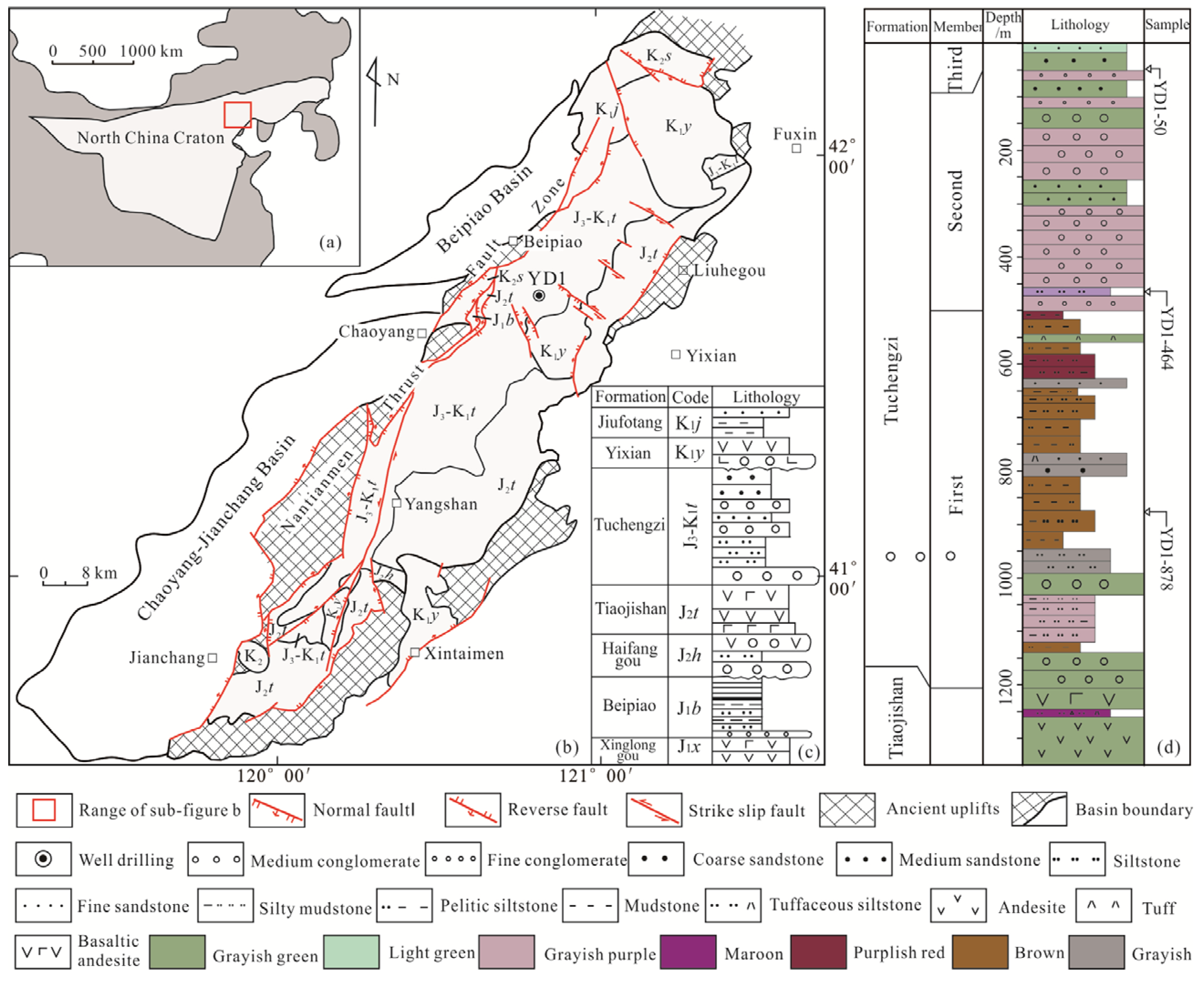
5. Analytical Methods and Sample Characteristics
5.1. Sample Characteristics
5.2. Analytical Methods
6. Results of Zircon U-Pb Dating
6.1. Glassy Crystal Tuff (YD1-50)
6.2. Calcareous Feldspar Lithic Sandstone (YD1-464)
6.3. Rhyolitic Tuff (YD1-878)
7. Discussion
7.1. Age of the Tuchengzi Formation
7.2. The Boundary between Jurassic and Cretaceous
7.3. Potential Areas and Layers for the Development of the Terrestrial Jurassic-Cretaceous Boundary
8. Conclusions
- (1)
- The zircon U-Pb dating of two tuff samples from Members 1 and 3 of the Tuchengzi Formation in well YD1 constrained the sedimentary age range from 153.8 to 137.16 Ma, although the upper age may be much later than 137.16 Ma. According to the International Stratigraphic Chronology (2018), the age of the Tuchengzi Formation in western Liaoning province was determined to be from the middle–late Late Jurassic to the Early Cretaceous.
- (2)
- A total of six zircon grains collected from the bottom of Member 2 of the Tuchengzi Formation (YD-464) yielded a weighted mean age of 145.7 ± 2.1 Ma, which is consistent with the peak age of the sample within the error range, and can be roughly used as the sedimentary period for this formation. Therefore, there may be a depositional gap between Members 2 and 1 of the Tuchengzi Formation, or at the top of Member 1, which can be regarded as the Jurassic–Cretaceous boundary of the Mesozoic terrestrial strata in western Liaoning Province. This conclusion is consistent with the Jurassic–Cretaceous boundary inferred by paleontological assemblage characteristics in recent years.
- (3)
- The Tuchengzi Formation in the Jibei–Liaoxi region, the Dongrong Formation, and the Dong’anzhen Formation in eastern Heilongjiang are key layers that may contain the terrestrial Jurassic–Cretaceous boundary. The Jurassic–Cretaceous boundary may be only locally developed in the Songliao Basin, and the Huolshiling Formation in the south is a key layer in the study of the Jurassic–Cretaceous boundary.
Supplementary Materials
Author Contributions
Funding
Data Availability Statement
Acknowledgments
Conflicts of Interest
References
- Remane, J. International stratigraphic chart, with explanatory note. In Proceedings of the 31st International Geological Congress, Rio de Janeiro, Brazil, 6–17 August 2000; pp. 1–16, (In Chinese with English Abstract). [Google Scholar]
- Cohen, K.M.; Finney, S.C.; Gibbard, P.L.; Fan, J.X. The ICS international chronostratigraphic chart. Phase 2013, 36, 199–204. [Google Scholar] [CrossRef] [PubMed]
- Wan, X.Q.; Gao, L.F.; Qin, Z.H.; Cui, C.; Li, W.; Xi, D.P. Jurassic-Cretaceous boundary and its terrestrial issue in Northern China. Earth Sci. Front. 2016, 23, 312–322, (In Chinese with English Abstract). [Google Scholar]
- Zheng, Y.J.; Chen, S.W.; Ding, Q.H.; Li, Y.F.; Zhang, J.; Wang, J.; Li, X.H.; Su, F.; Gao, X.Y. Chronostratigraphy of the Jurassic Tuchengzi Formation in Northern Hebei and Western Liaoning, China. Geol. Resour. 2010, 19, 293–295, (In Chinese with English Abstract). [Google Scholar]
- Pang, Q.Q.; Li, P.X.; Tian, S.G.; Liu, Y.Q. Discovery of ostracods in the Dabeigou and Dadianzi Formations at Zhangjiagou, Luanping County, northern Hebei Province of China and new progress in the biostratigraphic boundary study. Geol. Bull. China 2002, 21, 329–338, (In Chinese with English Abstract). [Google Scholar]
- Liu, Y.Q.; Pang, Q.Q.; Li, P.X.; Tian, S.G.; Niu, S.W. Advances in the study of non-marine Jurassic-Cretaceous biostratigraphi cal boundary and candidate stratotype in Luanping basin,northern Hebei. Geol. Bull. China 2002, 21, 176–180, (In Chinese with English Abstract). [Google Scholar]
- Wang, Q.F.; Chen, P.J. A brief introduction to the Cretaceous chronostratigraphic study. J. Stratigr. 2005, 29, 114–123, (In Chinese with English Abstract). [Google Scholar]
- Tian, S.G.; Niu, S.W.; Pang, Q.Q. Redefinition of the Lower Cretaceous terrestrial Yixianian Stage and its stratotype candidate in the Luanping basin, northern Hebei, China. Geol. Bull. China 2008, 27, 739–752, (In Chinese with English Abstract). [Google Scholar]
- Tian, S.G.; Pang, Q.Q.; Niu, S.W.; Li, P.X.; Liu, Y.Q. Terrestrial Jurassic-Cretaceous boundary stratotype candidate in Luanping basin, northern Hebei. Geol. Bull. China 2004, 23, 1170–1179, (In Chinese with English Abstract). [Google Scholar]
- Ji, Q.; Liu, Y.Q.; Ji, S.A.; Chen, W.; Lu, J.C.; You, H.L.; Yuan, C.X. On the terrestrial Jurassic-Cretaceous Boundary in China. Geol. Bull. China 2006, 25, 336–339, (In Chinese with English Abstract). [Google Scholar]
- Zhou, Z.H.; He, H.Y.; Wang, X.L. The continental Jurassic-Cretaceous Boundary in China. Acta Palaeontol. Sin. 2009, 48, 541–555, (In Chinese with English Abstract). [Google Scholar]
- Xu, H.; Liu, Y.Q.; Kuang, H.W.; Jiang, X.J.; Peng, N. U-Pb SHRIMP age for the Tuchengzi Formation, northern China, and its implications for biotic evolution during the Jurassic-Cretaceous transition. Palaeoworld 2012, 21, 222–234. [Google Scholar] [CrossRef]
- Wan, X.Q.; Li, G.; Huang, Q.H.; Xi, D.P.; Chen, P.J. Division and correlation of terrestrial cretaceous stages in China. J. Stratigr. 2013, 37, 457–471, (In Chinese with English Abstract). [Google Scholar]
- Casellato, C.E. Calcareous nannofossil biostratigraphy of Upper Callovian—Lower Berriasian succession from the southern Alps, North Italy. Riv. Ital. Di Paleontol. Stratigr. 2010, 116, 357–404. [Google Scholar]
- Gradstein, F.M.; Ogg, J.G.; Schmitz, M.D. The Geologic Time Scale; Elsevier: Amsterdam, The Netherlands, 2012; pp. 795–813. [Google Scholar]
- Mahoney, J.J.; Duncan, R.A.; Tejada, M.L.G.; Sager, W.W.; Bralower, T.J. Jurassic-Cretaceous boundary age and mid-ocean-ridge–type mantle source for Shatsky Rise. Geology 2005, 33, 185–188. [Google Scholar] [CrossRef]
- Liu, Y.Q.; Ji, Q.; Jiang, X.J.; Kuang, H.W.; Ji, S.; Gao, L.F.; Zhang, Z.G.; Peng, N.; Yuan, C.X.; Wang, X.R. U-Pb zircon ages of early Cretaceous volcanic rocks in the Tethyan Himalaya at Yangzuoyong Co Lake, Negarze, Southern Tibet, and implications for the Jurassic/Cretaceous boundary. Cretac. Res. 2013, 40, 90–101. [Google Scholar] [CrossRef]
- Vennari, V.V.; Lescano, M.; Naipauer, M.; Aguirre-Urreta, B.; Concheyro, A.; Schaltegger, U.; Armstrong, R.; Pimentel, M.; Ramos, V.A. New constraints on the Jurassic-Cretaceous boundary in the High Andes using high-precision U-Pb data. Gondwana Res. 2014, 26, 374–385. [Google Scholar] [CrossRef]
- Chen, P.J. Comments on the Classification and Correlation of Non-marine Jurassic and Cretaceous of China. J. Stratigr. 2000, 24, 114–119, (In Chinese with English Abstract). [Google Scholar]
- All China Commission of Stratigraphy. Specification of Regional Chronostratigraphic (Geological) Chronology in China; Geological Press: Beijing, China, 2002; pp. 1–72, (In Chinese with English Abstract). [Google Scholar]
- Pang, Q.Q.; Tian, S.G.; Li, P.X.; Niu, S.W.; Liu, Y.Q. Ostracod biostratigraphy of the Dabeigou and Dadianzi formations and Jurassic-Cretaceous boundary in the Luanping basin, northern Hebei, China. Geol. Bull. China 2006, 25, 348–356, (In Chinese with English Abstract). [Google Scholar]
- Niu, S.W.; Tian, S.G.; Pang, Q.Q. Conchostracan biostratigraphy of the Dadianzi Formation in the Luanping basin, northern Hebei, China and the boundary of continental Jurassic and Cretaceous strata. Geol. Bull. China 2010, 29, 961–979, (In Chinese with English Abstract). [Google Scholar]
- Wang, W.L.; Zhang, L.J.; Zheng, S.L.; Ren, D.; Zheng, Y.J.; Ding, Q.H.; Zhang, H.; Li, Z.T.; Yang, F.L. The age of the Yixianian Stage and the boundary of Jurassic-Cretaceous—The establishment and study of stratotypes of the Yixianian Stage. Geol. Rev. 2005, 51, 234–242, (In Chinese with English Abstract). [Google Scholar]
- Yin, H.F. Notes on the compilation of China stratigraphic table and the revision of China stratigraphic guide. J. Stratigr. 2014, 38, 123–125, (In Chinese with English Abstract). [Google Scholar]
- Swisher, C.C., III; Wang, Y.L.; Zhou, Z.H.; Wang, Y.Q.; Jin, F.; Zhang, J.Y.; Xue, X.; Zhang, F.C.; Wang, Y. New evidence of isotopic age of Yixian Formation and 40Ar/39Ar dating of Tuchengzi Formation. Chin. Sci. Bull. 2001, 46, 2009–2012, (In Chinese with English Abstract). [Google Scholar]
- Davis, G.A. The Late Jurassic “Tuchengzi/Houcheng” Formation of the Yanshan fold-thrust belt: An analysis. Earth Sci. Front. 2005, 12, 331–345. [Google Scholar]
- Zhang, H.; Yuan, H.L.; Hu, Z.C.; Liu, X.M.; Diwu, C.R. U-Pb Zircon dating of the Mesozoic volcanic strata in Luanping of North Hebei and its significance. Earth Sci. J. China Univ. Geosci. 2005, 30, 707–720, (In Chinese with English Abstract). [Google Scholar]
- Sun, L.X.; Zhao, F.Q.; Wang, H.C.; Gu, Y.C.; Ji, S.P. Correlationship of Tuchengzi Formation and implications of the Basin Tectonic Evolution in the Intracontinental Yanshan Orogenic Belt. Acta Geol. Sin. 2007, 81, 445–453, (In Chinese with English Abstract). [Google Scholar]
- Xu, H.; Liu, Y.Q.; Kuang, H.W.; Peng, N. Ages of the Tuchengzi Formation in northern China and the terrestrial Jurassic-Cretaceous boundary in China. Earth Sci. Front. 2014, 21, 203–215, (In Chinese with English Abstract). [Google Scholar]
- Shen, Y.B.; Chen, P.J. Late Middle Jurassic conchostracans from the Tuchengzi Formation of W. Liaoning, NE China. Bulletin of Nanjing Institute of Geology and Palaeontology. Chin. Acad. Sci. 1984, 9, 309–326, (In Chinese with English Abstract). [Google Scholar]
- Wang, S.N. Correlation of the continental Jurassic in The North of China to the Paralic Jurassic in Northwest Scotland, United Kingdom with a discussion of the stratigraphic subdivision and correlation of the Jurassic in the North of China. Acta Geol. Sin. 1998, 72, 11–20. [Google Scholar]
- Wang, W.L.; Zhang, H.; Zhang, L.J.; Zheng, S.L.; Yang, F.L.; Li, Z.T.; Zheng, Y.J.; Ding, Q.H. Standard Sections of Tuchengzi Stage and Yixian Stage and Their Stratigraphy, Palaeontology and Tectonic-Volcanic Actions; Geological Publishing House: Beijing, China, 2004; pp. 21–91, (In Chinese with English Abstract). [Google Scholar]
- Wang, S.E.; Li, G. New fossil clam shrimps from the Tuchengzi formation of Northern Hebei and Western Liaoning. Acta Palaeontol. Sin. 2008, 47, 319–325, (In Chinese with English Abstract). [Google Scholar]
- Wang, S.E.; Gao, L.Z.; Wan, X.Q.; Song, B. Ages of Tuchengzi formation in western Liaoning-northern Hebei area in correlation with those of international strata. Geol. Bull. China 2013, 32, 1673–1690, (In Chinese with English Abstract). [Google Scholar]
- Deng, S.H.; Lu, Y.Z.; Zhao, Y.; Fan, R.; Wang, Y.D.; Yang, X.J.; Li, X.; Sun, B.N. The Jurassic palaeoclimate regionalization and evolution of China. Earth Sci. Front. 2017, 24, 106–142, (In Chinese with English Abstract). [Google Scholar]
- Li, G.; Matsuoka, A. Searching for a non-marine Jurassic/Cretaceous boundary in northeastern China. J. Geol. Soc. Jpn. 2015, 121, 109–122. [Google Scholar]
- Li, W.; Wan, X.Q.; Atsushi, M.; Zhang, S.Q.; Qu, H.Y.; Tsubasa, T.; Kohei, Y. Jurassic-Cretaceous boundary strata of the Somanakamura Group in NE Japan and their correlation with coeval terrestrial deposits in China. Acta Geol. Sin. 2015, 89, 285–299. [Google Scholar]
- Deng, S.H.; Wang, S.E.; Yang, Z.Y.; Lu, Y.Z.; Li, X.; Hu, Q.Y.; An, C.Z.; Xi, D.P.; Wan, X.Q. Comprehensive Study of the Middle–Upper Jurassic strata in the Junggar Basin, Xinjiang. Acta Geosci. Sin. 2015, 36, 559–574, (In Chinese with English Abstract). [Google Scholar]
- Wang, D.N.; Wang, X.R.; Ji, Q. The Palynoflora alternation and the Paleoclimate change at the turning time between Late Jurassic and Early Cretaceous in Northern Hebei and Western Liaoning. Acta Geosci. Sin. 2016, 37, 449–459, (In Chinese with English Abstract). [Google Scholar]
- Liu, S.F.; Lin, C.F.; Liu, X.B.; Zhuang, Q.T. Syn-tectonic sedimentation and its linkage to fold-thrusting in the region of Zhangjiakou, North Hebei, China. Sci. China Earth Sci. 2018, 61, 681–710. [Google Scholar] [CrossRef]
- Wan, X.Q.; Sun, L.X. Terrestrial Fossil Assemblages of Tuchengzi Formation and Jurassic-Cretaceous Boundary chronostratigraphy in Yanliao Area. Acta Palaeontol. Sin. 2020, 59, 1–12, (In Chinese with English Abstract). [Google Scholar]
- Liu, Y.J.; Zhang, X.Z.; Jin, W.; Chi, X.G.; Wang, C.W.; Ma, Z.H.; Han, G.Q.; Wen, Q.B.; Li, W.; Wang, W.D.; et al. Late Paleozoic tectonic evolution in Northeast China. Geol. China 2010, 37, 943–951, (In Chinese with English Abstract). [Google Scholar]
- Wang, C.W.; Sun, Y.W.; Li, N.; Zhao, G.W.; Ma, X.Q. Tectonic implications of late Paleozoic stratigraphic distribution in Northeast China and adjacent region. Sci. China Ser. D Earth Sci. 2009, 52, 619–626. [Google Scholar] [CrossRef]
- Zhou, J.B.; Wilde, S.A.; Zhang, X.Z.; Zhao, G.C.; Zheng, C.Q.; Wang, Y.J.; Zhang, X.H. The onset of Pacific margin accretion in NE China: Evidence from the Heilongjiang high-pressure metamorphic belt. Tectonophysics 2009, 478, 230–246. [Google Scholar] [CrossRef]
- Wang, P.J.; Zhao, R.L.; Meng, Q.A.; Qu, X.J.; Zhu, D.F.; Gao, Y.F. The Cretaceous Songliao Basin: Dynamic background from volcanic rift to interior sag basin. Earth Sci. Front. 2015, 22, 99–117, (In Chinese with English Abstract). [Google Scholar]
- Zhang, X.Z.; Guo, Y.; Zeng, Z.; Fu, Q.L.; Pu, J.B. Dynamic evolution of the Mesozoic-Cenozoic basins in the northeastern China. Earth Sci. Front. 2015, 22, 88–98, (In Chinese with English Abstract). [Google Scholar]
- Dong, S.W.; Zhang, Y.Q.; Chen, X.H.; Long, C.X.; Wang, T.; Yang, Z.Y.; Hu, J.M. The formation and deformational characteristics of East Asia multi-direction convergent tectonic system in Late Jurassic. Acta Geosci. Sin. 2008, 29, 306–317, (In Chinese with English Abstract). [Google Scholar]
- Dong, S.W.; Zhang, Y.Q.; Li, H.L.; Shi, W.; Xue, H.M.; Li, J.H.; Huang, S.Q.; Wang, Y.C. The Yanshan orogeny and late Mesozoic multi-plate convergence in East Asia—Commemorating 90th years of the “Yanshan Orogeny”. Sci. China Earth Sci. 2018, 61, 1888–1909. [Google Scholar] [CrossRef]
- Xing, D.H.; Sun, C.L.; Sun, Y.W.; Zhang, L.D.; Guo, S.Z.; Zhang, C.J.; Peng, Y.D.; Jia, B.; Chen, S.W.; Ding, Q.H. Stratigraphic sequence of Tuchengzi Formation in Jinlingsi-Yangshan Basin, Western Liaoning Province. Geol. Resour. 2006, 15, 166–173, (In Chinese with English Abstract). [Google Scholar]
- Xing, D.H.; Zhang, L.D.; Guo, S.Z.; Zhang, C.J.; Peng, Y.D.; Jia, B.; Chen, S.W.; Ding, Q.H.; Zheng, Y.J. Sequence stratigraphy of the Tuchengzi Formation in the northern part of the Jinlingsi-Yangshan basin, western Liaoning, and basin evolution. Chin. Geol. 2001, 28, 5–12, (In Chinese with English Abstract). [Google Scholar]
- He, B.; Li, M.F.; Liu, Y.X. Jinlingsi-Yangshan Basin Beipiao Formation hydrocarbon source rock characteristics. Coal Geol. China 2008, 20, 25–27, (In Chinese with English Abstract). [Google Scholar]
- Wong, W.H. Tectonic studies on Beipiao area of Jehol. Geol. Rep. 1928, 11, 23, (In Chinese with English Abstract). [Google Scholar]
- Wong, W.H. Crustal movements and igneous activities in eastern China since Mesozoic time. Bull. Geol. Soc. China 1927, 6, 9–37. [Google Scholar] [CrossRef]
- Zhang, H.R.; Zhang, Y.K.; Cai, X.M.; Qu, H.J.; Li, H.L.; Wang, M. The triggering of Yanshan Movement: Yanshan Event. Acta Geol. Sin. 2013, 87, 1779–1790. [Google Scholar]
- Huang, D.Y. Yanliao Biota and Yanshan Movement. Acta Palaeontol. Sin. 2015, 54, 501–546, (In Chinese with English Abstract). [Google Scholar]
- Zhang, R.H. The phasing of Yanshan Movement and its several important questions. Acta Geol. Sin. 2016, 90, 2176–2180, (In Chinese with English Abstract). [Google Scholar]
- Zhu, J.C.; Feng, Y.C.; Meng, Q.R.; Wu, F.C.; Li, H.; Liu, H.T.; Zhang, F.P.; Wang, T.Y.; Wu, G.L.; Zou, C.N.; et al. Late Mesozoic tectonostratigraphic division and correlation of Bohai Bay basin: Implications for the Yanshanian Orogeny. Sci. China Earth Sci. 2020, 62, 1783–1804. [Google Scholar] [CrossRef]
- Xi, D.P.; Wan, X.Q.; Li, G.B.; Li, G. Cretaceous integrative stratigraphy and timescale of China. Sci. China Earth Sci. 2019, 62, 256–286. [Google Scholar] [CrossRef]
- Huang, D.Y. Jurassic integrative stratigraphy and timescale of China. Sci. China Earth Sci. 2019, 62, 223–255. [Google Scholar] [CrossRef]
- Xu, W.L.; Wang, F.; Pei, F.P.; Meng, E.; Tang, J.; Xu, M.J.; Wang, W. Mesozoic tectonic regimes and regional ore-forming background in NE China: Constraints from spatial and temporal variations of Mesozoic volcanic rock associations. Acta Petrol. Sin. 2013, 29, 339–353, (In Chinese with English Abstract). [Google Scholar]
- Dong, S.W.; Zhang, Y.Q.; Long, C.X.; Yang, Z.Y.; Ji, Q.; Wang, T.; Hu, J.M.; Chen, X.H. Jurassic tectonic revolution in China and new interpretation of the Yanshan Movement. Acta Geol. Sin. 2007, 81, 1449–1461, (In Chinese with English Abstract). [Google Scholar]
- Yang, X.D.; Li, X.Y. Stratigraphy (Lithostratic) of Liaoning Province; China University of Geosciences Press: Wuhan, China, 1997; pp. 1–247, (In Chinese with English Abstract). [Google Scholar]
- Zhai, M.G.; Hu, B.; Zhao, T.P.; Peng, P.; Meng, Q.R. Late Paleoproterozoic–Neoproterozoic multi-rifting events in the North China Craton and their geological significance: A study advance and review. Tectonophysics 2015, 662, 153–166. [Google Scholar] [CrossRef]
- Sun, S.L.; Li, Y.F.; Gao, X.Y.; Zhou, T.S.; Zhang, T.; Wang, S.H. An analysis of the genesis and geochemical characteristics of shale gas in Lower Jurassic Beipiao Formation in Jinyang Basin. Geol. Bull. China 2017, 36, 575–581, (In Chinese with English Abstract). [Google Scholar]
- Liu, Y.S.; Hu, Z.C.; Zong, K.Q.; Gao, C.G.; Chen, H.H. Reappraisement and refinement of zircon U-Pb isotope and trace element analyses by LA-ICP-MS. Chin. Sci. Bull. 2010, 55, 1535–1546. [Google Scholar] [CrossRef]
- Liu, Y.S.; Gao, S.; Hu, Z.C.; Gao, C.G.; Zong, K.Q.; Wang, D.B. Continental and oceanic crust recycling-induced melt-peridotite interactions in the Trans-North China Orogen:U-Pb Dating,Hf isotopes and trace elements in zircons from mantle xenoliths. J. Petrol. 2010, 51, 537–571. [Google Scholar] [CrossRef]
- Ludwig, K.R. ISOPLOT 3.0: A Geochronological Toolkit for Microsoft Excel; Special Publication: Berkeley, CA, USA, 2003; p. 70. [Google Scholar]
- Belousova, E.A.; Griffin, W.L.; O’Reilly, S.Y.; Fisher, N. Igneous zircon: Trace element composition as an indicator of source rock type. Contrib. Mineral. Petrol. 2002, 143, 602–622. [Google Scholar] [CrossRef]
- Hoskin, P.W.O.; Ireland, T.R. Rare earth element chemistry of zircon and its use as a provenance indicator. Geology 2000, 28, 627–630. [Google Scholar] [CrossRef]
- Pang, Q.Q. Ostracods from middle and Upper Jurassic in Yanshan area, Hebei Province and their stratigraphic significance. J. Hebei GEO Univ. 1982, Z1, 89–110, (In Chinese with English Abstract). [Google Scholar]
- Pu, R.G.; Wu, H.Z. Palynopollen assemblage of middle and late Jurassic in western Liaoning Province. J. Shenyang Inst. Geol. Miner. Resour. 1982, 4, 169–184, (In Chinese with English Abstract). [Google Scholar]
- Yang, R.Q. Jurassic-Cretaceous ostracods assemblage in Hebei Province and its stratigraphic significance. J. Hebei GEO Univ. 1984, 4, 30–46, (In Chinese with English Abstract). [Google Scholar]
- Xiao, Z.Z.; Yang, H.L.; Shan, Q.S. Mesozoic Strata and Biota in Beijing; Geological Press: Beijing, China, 1994; pp. 119–121, (In Chinese with English Abstract). [Google Scholar]
- Hong, Y.C. Discovery of fossil insects from Houcheng Formation of Hebei Province and establish of Houcheng Entomofauna. Beijing Geol. 1997, 1, 1–7, (In Chinese with English Abstract). [Google Scholar]
- Zheng, S.L. Division, Correlation and Age of Tuchengzi Formation in Northern Hebei and Western Liaoning: Editorial Board of Theses of the Third National Stratigraphic Conference//Proceedings of the Third National Stratigraphic Conference; Geological Press: Beijing, China, 2000; pp. 227–232, (In Chinese with English Abstract). [Google Scholar]
- Zheng, S.L.; Zhang, W.; Ding, Q.H. Discovery of fossil plants from Middle-Upper Jurassic Tuchengzi Formation in Western Liaoning, China. Acta Palaeontol. Sin. 2001, 40, 67–85, (In Chinese with English Abstract). [Google Scholar]
- Wang, S.E.; Ji, Q. A Comprehensive Study of the Continental Upper Jurassic Tuchengzi Stage in China//the Third National Stratigraphic Commission: A Study Report on the Establishment of the Main Chronological Strata In China; Geological Press: Beijing, China, 2008; pp. 105–114, (In Chinese with English Abstract). [Google Scholar]
- He, Z.J.; Wang, Z.Q.; Ren, J.S. A preliminary research on sedimentary features and genetic mechanism of frontal basins before Jurassic large-scale nappe in the Northern Region of North China. Chin. J. Geol. 1999, 34, 186–195, (In Chinese with English Abstract). [Google Scholar]
- He, Z.J.; Li, J.Y.; Niu, B.G.; Ren, J.H. A late Jurassic intense thrusting-uplifting event in the Yanshan—Yinshan area, Northern China, and its sedimentary response. Geol. Rev. 1998, 44, 407–418, (In Chinese with English Abstract). [Google Scholar]
- Wang, Z.J.; Huang, Z.G.; Yao, J.X.; Ma, X.L. Characteristics and main progress oft the stratigraphic chart of China and directions. Acta Geosci. Sin. 2014, 35, 271–276, (In Chinese with English Abstract). [Google Scholar]
- Huang, Z.A.; Pan, Y.Q.; Yang, Y.J. Regional Geological Survey Report of 1:250,000 Zone in Jinzhou; Liaoning Provincial Institute of Geology and Mineral Resources Investigation: Dalian, China, 2003; pp. 1–391, (In Chinese with English Abstract). [Google Scholar]
- Fan, J.X.; Chen, D.Y.; Hou, X.D. The International Chronostratigraphic Chart (v 2016/04), Its color model and application. J. Stratigr. 2016, 40, 341–348, (In Chinese with English Abstract). [Google Scholar]
- Lin, M.Q.; Li, J.G.; Peng, J.G. Early Cretaceous palynological assemblages from the Third Member of the Tuchengzi Formation at Sihetun, Beipiao County, Western Liaoning Province, Northeast China and their implications. Acta Micropalaeontologica Sin. 2016, 33, 261–271, (In Chinese with English Abstract). [Google Scholar]
- Kozhevnikov, V.M.; Ruzhentsev, S.V.; Dergunov, A.B.; Filippova, I.B.; Tomurtogoo, O.; Arvisbaatar, N.; Bayasgalan, T. The South Siberia—Central Mongolia transect. Tectonophysics 1993, 225, 361–378. [Google Scholar]
- Zorin, Y.A. Geodynamics of the western part of the Mongolia-Okhotsk collisional belt, Trans-Baikal region (Russia) and Mongolia. Tectonophysics 1999, 306, 33–56. [Google Scholar] [CrossRef] [Green Version]
- Mo, S.G.; Han, M.L.; Li, J.Y. Compositions and orogenic processes of Mongolia-Okhotsk Orogen. J. Shandong Univ. Sci. Technol. 2005, 24, 50–52, 64, (In Chinese with English Abstract). [Google Scholar]
- Kravchinsky, V.A.; Cogné, J.P.; Harbert, W.P.; Kuzmin, M.I. Evolution of the Mongol-Okhotsk Ocean as constrained by new palaeomagnetic data from the Mongol-Okhotsk suture zone, Siberia. Geophys. J. Int. 2002, 148, 34–57. [Google Scholar] [CrossRef] [Green Version]
- Sorokin, A.A.; Sorokin, A.P.; Ponomarchuk, V.A.; Travin, A.V. The age and geochemistry of volcanic rocks on the eastern flank of the Umlekan-Ogodzha volcanoplutonic belt (Amur region). Russ. Geol. Geophys. 2010, 51, 369–379. [Google Scholar] [CrossRef]
- Wang, C.Y.; Wang, D.B.; Qu, J.J. Chronology and geochemistry of rhyolites in Manketou’ebo Formation from Keyihe area,north-central Greater Xing’an Range. J. Heilongjiang Univ. Sci. Technol. 2017, 27, 46–50, (In Chinese with English Abstract). [Google Scholar]
- Gao, L.F.; He, Z.H.; Sui, Z.M.; Lu, K.J.; Liu, F.Y. Chronology and geochemistry of volcanic rocks from Manketouebo Formation in the Suolun area, central Da Hinggan Mountains and their tectonic implications. Geol. Bull. China 2018, 37, 881–894, (In Chinese with English Abstract). [Google Scholar]
- Liu, K.; Wu, T.T.; Liu, J.L.; Bao, Q.Z.; Du, S.Y. Geochronology and geochemistry of volcanic rocks in Manketou’ebo Formation of Tulihe area, northern Da Hinggan Mountains. Geol. China 2018, 45, 367–376, (In Chinese with English Abstract). [Google Scholar]
- Guo, J.G.; Zhang, Y.J.; Zhang, C.; Li, W.; Wang, Y.; Wang, Q.Z.; Guo, J. Formation age and geochemical characteristics of volcanic rocks in Manketou’ebo Formation in Kundu area of Ar Horqin Banner, Inner Mongolia. Geol. Bull. China 2018, 37, 1652–1661, (In Chinese with English Abstract). [Google Scholar]
- Jia, B.; Wei, L.Y.; Wu, H.H.; Zhang, Z.; Tang, W.D.; Liu, T.H.; Chai, C.H.; Meng, W.Y. Chronology, geochemistry and geological significance of volcanic rocks of the Manketouebo Formation in Horqin Right-Front Banner area, Inner Mongolia. Acta Petrol. Et Mineral. 2021, 40, 859–873, (In Chinese with English Abstract). [Google Scholar]
- Si, Q.L.; Cui, T.R.; Tang, Z.; Li, W.; Wu, X.W.; Jiang, B.; Li, L.C. Chronology, geochemistry and petrogenesis of the volcanic rocks in Manitu Formation in Chaihe Area, Central Great Xing’an Range. J. Jilin Univ. Earth Sci. Ed. 2015, 45, 389–403, (In Chinese with English Abstract). [Google Scholar]
- Zhang, X.; Zhen, S.U.; Gao, Y. Zircon U–Pb geochronology and geochemistry of the early Cretaceous volcanic rocks from the Manitu Formation in the Hongol Area, Northeastern Inner Mongolia. Acta Geol. Sin. Engl. Ed. 2017, 91, 1286–1304. [Google Scholar] [CrossRef]
- Tao, C.Z.; Li, Z.M.; Wang, D.Q.; Shen, X.; Zhang, Y.J.; Li, B. La-icp-ms zircon U-Pb dating and geochemistry of the volcanic rocks from manitu formation in Ulanhot region of southern Daxinganling. Geol. Resour. 2015, 24, 102–109, (In Chinese with English Abstract). [Google Scholar]
- Wang, C.Y.; Sun, D.Y.; Tian, L.H.; Bu, J.; Shang, Y.H. Latest zircon u-pb age of the baiyingaolao formation volcanic rocks in the keyihe area of north-central da hinggan mountains. Acta Geol. Sin. 2018, 92, 360–361. [Google Scholar] [CrossRef]
- Yin, Y.K.; Gao, Y.F.; Wang, P.J.; Qu, X.J.; Liu, H.B. Discovery of Triassic volcanic-sedimentary strata in the basement of Songliao Basin. Sci. Bull. 2019, 64, 644–646. [Google Scholar] [CrossRef] [Green Version]
- Liu, H.B.; Wang, P.J.; Gao, Y.F.; Hou, H.S.; Yin, Y.K.; Li, H.H.; Feng, Y.H. New data from ICDP borehole SK2 and its constraint on the beginning of the Lower Cretaceous Shahezi Formation in the Songliao Basin, NE China. Sci. Bull. 2020, 66, 411–413. [Google Scholar] [CrossRef]
- Gao, R.Q.; Xiao, D.M. New Progress in Oil and Gas Exploration in Songliao and Its Peripheral Basins; Petroleum Industry Press: Beijing, China, 1995; pp. 13–15, (In Chinese with English Abstract). [Google Scholar]
- Zhu, D.F.; Ren, Y.G.; Wu, H.Y.; Wu, G.Y.; Wan, C.B.; Wu, X.M. A preliminary study on the buried Permian and Jurassic in the Northern Songliao Basin. Chin. J. Geol. 2007, 42, 690–708, 778, (In Chinese with English Abstract). [Google Scholar]
- Qu, X.J.; Wang, P.J.; Gao, Y.F.; Wan, X.Q. Chronostratigraphy of Huoshiling Formation in the Songliao Basin, NE China. Earth Sci. Front. 2014, 21, 234–250, (In Chinese with English Abstract). [Google Scholar]
- Qu, X.J.; Wang, P.J.; Yao, R.S.; Gao, Y.F.; Bai, B. Stratigraphical sequence and regional correlation of Huoshiling Formation in southern Songliao Basin. J. Cent. South Univ. 2014, 45, 2716–2727, (In Chinese with English Abstract). [Google Scholar]
- Wang, P.J.; Liu, W.Z.; Wang, S.X.; Song, W.H. 40Ar/39Ar and K/Ar dating on the volcanic rocks in the Songliao basin, NE China: Constraints on stratigraphy and basin dynamics. Int. J. Earth Sci. 2002, 91, 331–340. [Google Scholar] [CrossRef]
- Lin, M.Q.; Li, J.G. Palynological assemblages from the Tuchengzi and Dabeigou formations in the Luanping Basin at Sanchazi Section, Northern Hebei Province and their implications. Acta Palaeontol. Sin. 2021, 60, 263–280, (In Chinese with English Abstract). [Google Scholar]
- Sun, G.; Sha, J.G.; Wang, Y.G.; Yuan, F.S.; Xiong, X.Z.; Piao, T.Y. Jurassic-Cretaceous Boundary of Dong’anzhen, Raohe, Heilongjiang with a new knowledge of Buchia. Acta Palaeontol. Sin. 1989, 28, 579–590, (In Chinese with English Abstract). [Google Scholar]
- Sun, G.; Zhen, S.L.; Sun, X.K.; He, C.Q.; Piao, T.Y.; Shang, Y.K.; Zhang, C.B.; Yu, Z.Z.; Zhao, Y.H. Recent advance in the research of the strata near the Jurassic-Cretaceous boundary in eastern Heilongjiang. J. Stratigr. 1992, 16, 49–54, 83, (In Chinese with English Abstract). [Google Scholar]
- Sun, X.K.; He, C.Q. Dinoflagellates from upper Jurassic dongrong formation of Suibin, Heilongjiang. Acta Palaeontol. Sin. 1992, 31, 190–205, 267. [Google Scholar]
- He, C.Q.; Zhu, Y.H. Dinoflagellate assemblage from the uppermost part of the Dongrong formation with discussion on Jurassic-Cretaceous boundary in Suibin area, Northeastern Heilongjiang province, Ne China. Acta Palaeontol. Sin. 2003, 42, 328–345, (In Chinese with English Abstract). [Google Scholar]
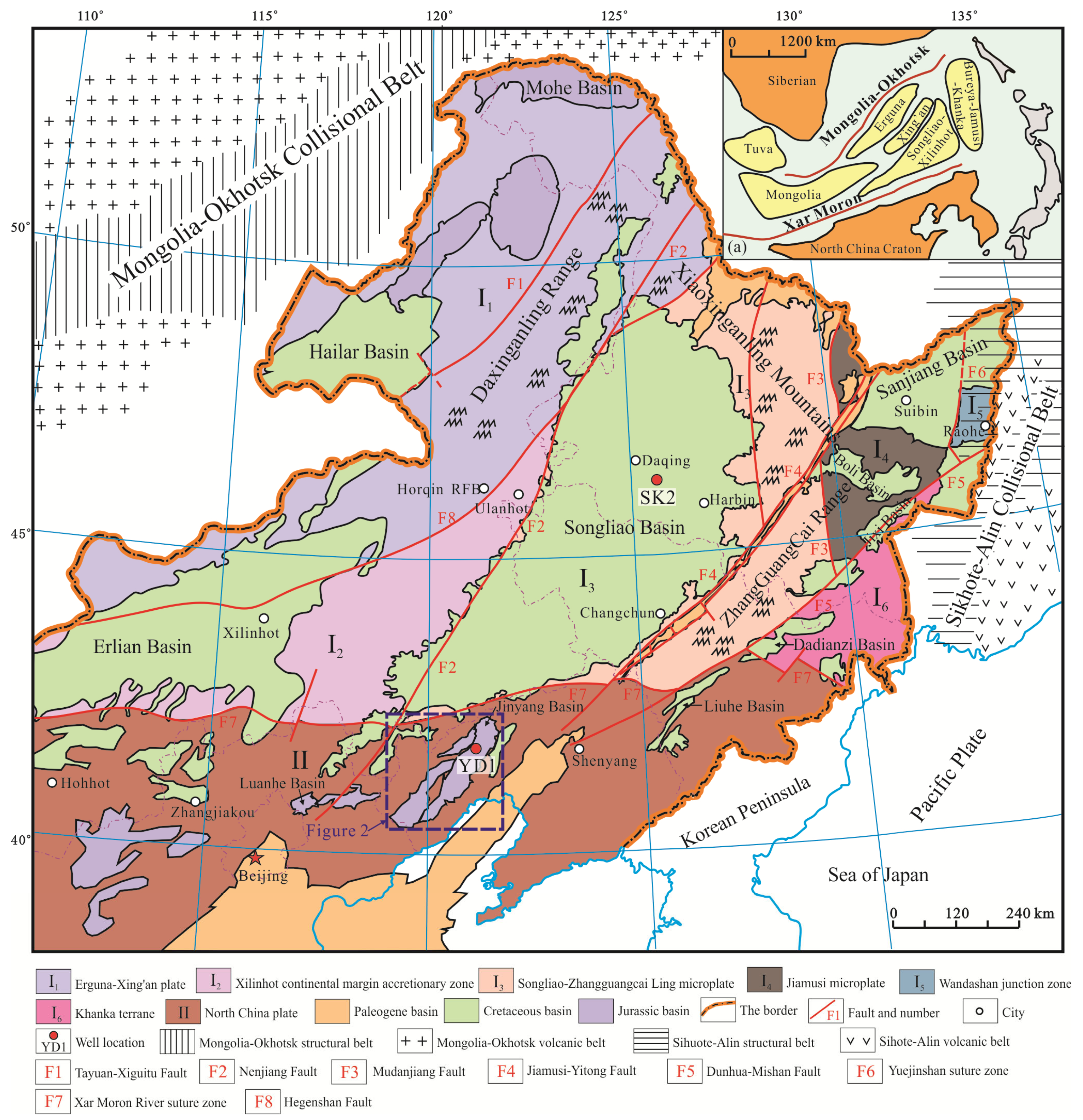
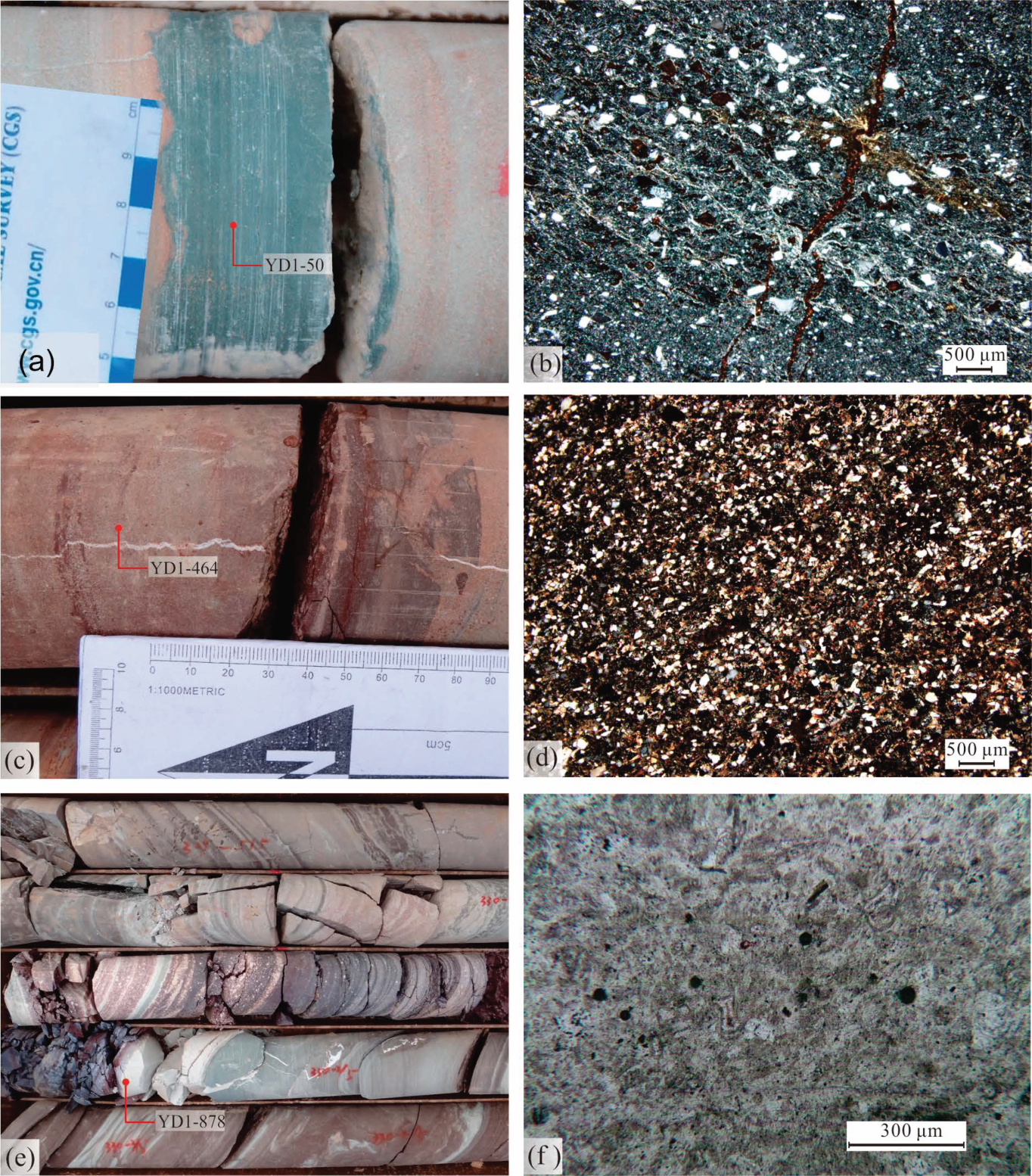
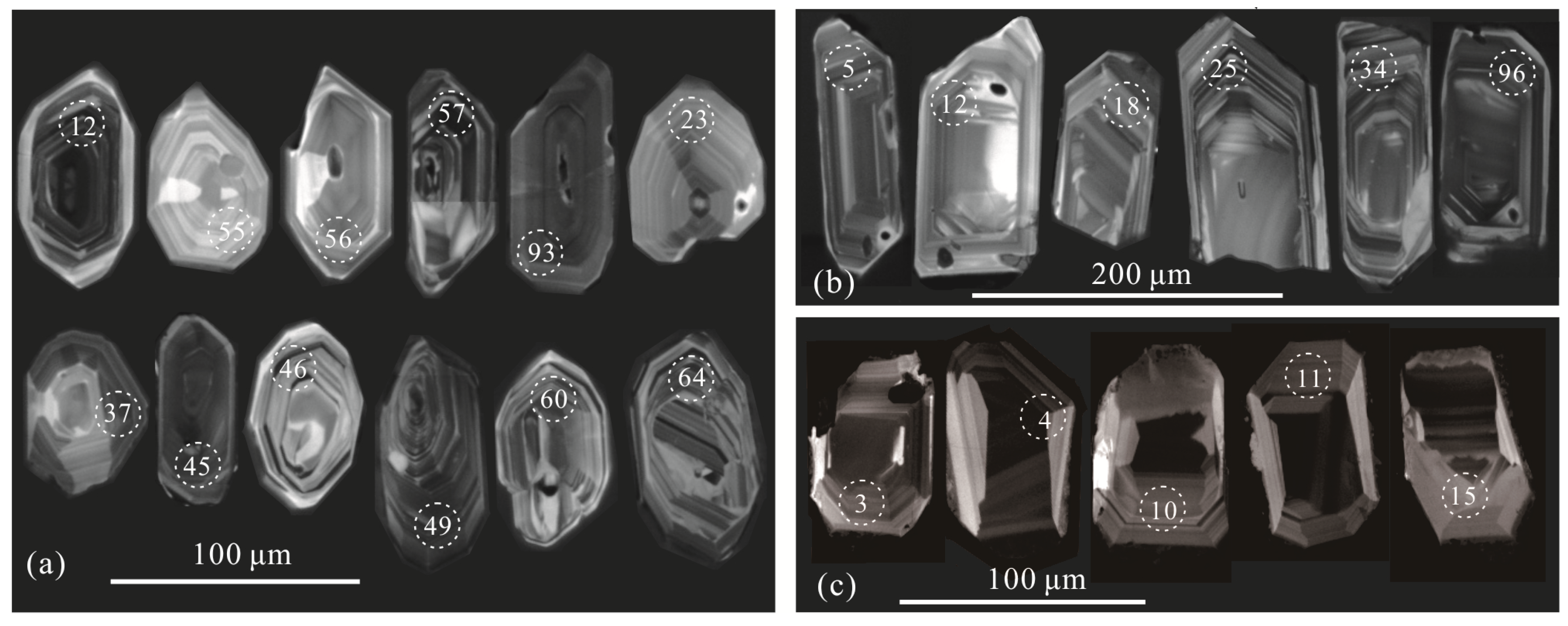
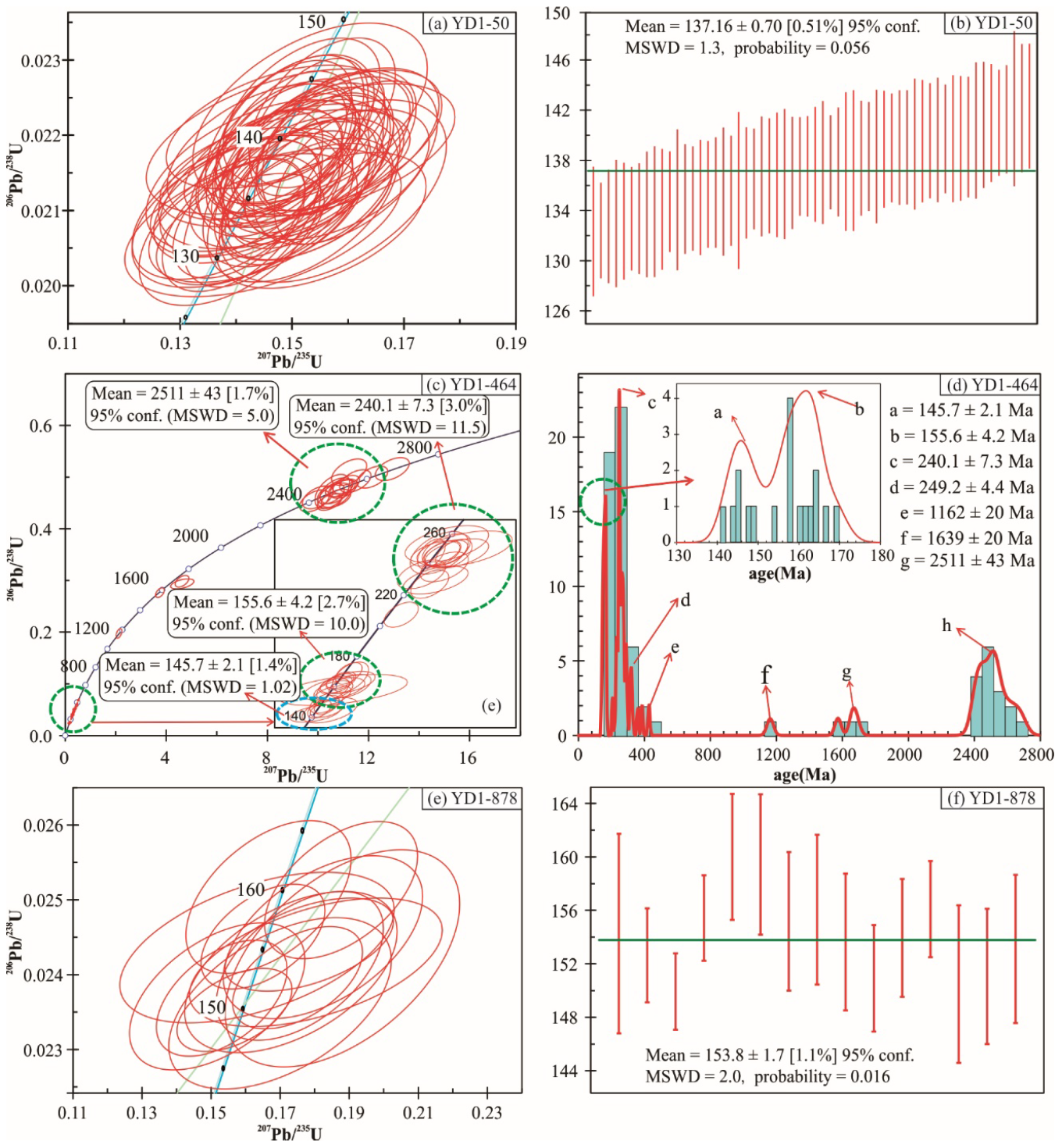
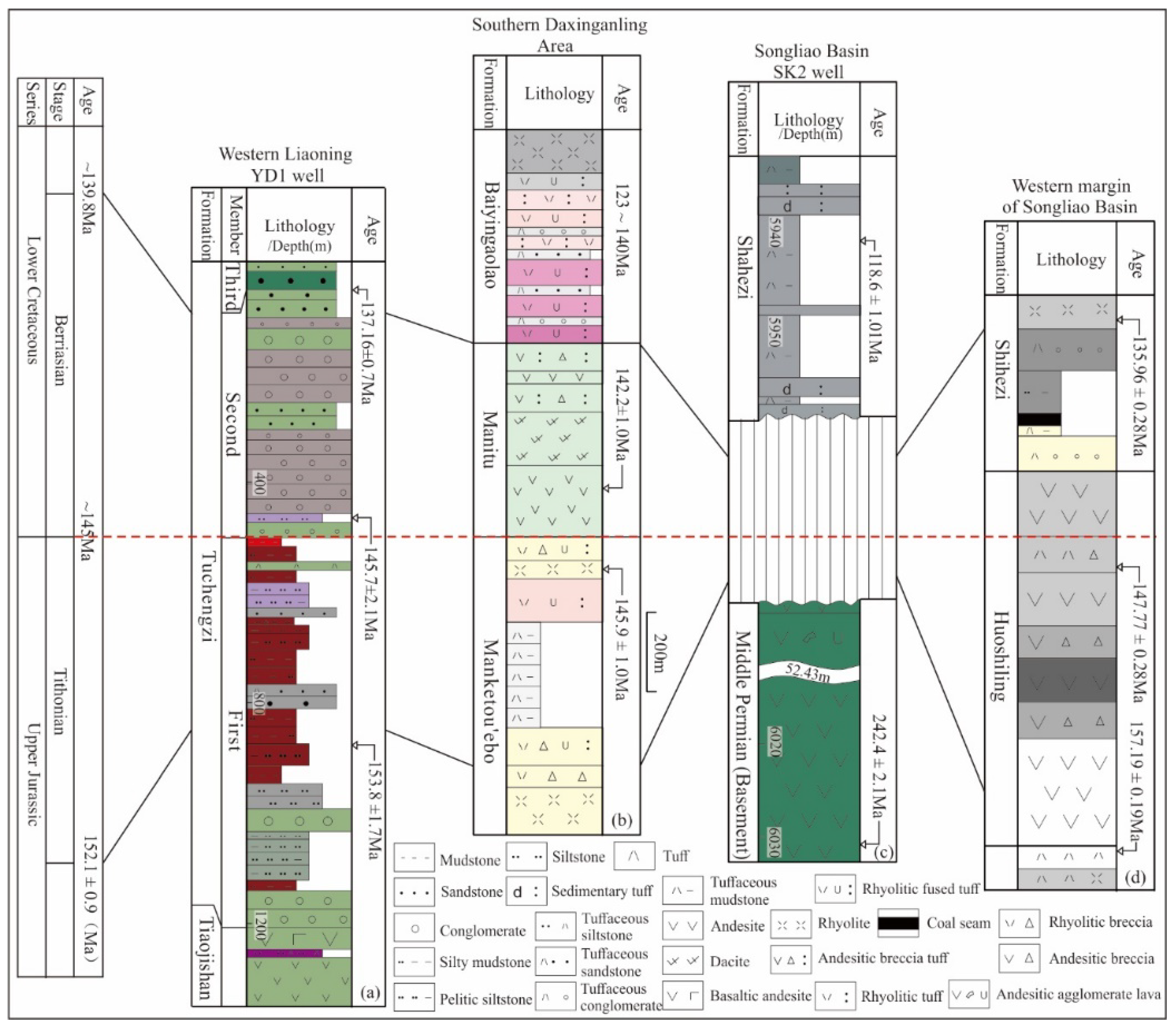
Publisher’s Note: MDPI stays neutral with regard to jurisdictional claims in published maps and institutional affiliations. |
© 2022 by the authors. Licensee MDPI, Basel, Switzerland. This article is an open access article distributed under the terms and conditions of the Creative Commons Attribution (CC BY) license (https://creativecommons.org/licenses/by/4.0/).
Share and Cite
Sun, S.-L.; Chen, S.-W.; Yang, Z.-J.; Zhang, T.; Li, Y.-F.; Zhu, J.-C.; Wu, H.-C.; Wang, T.-T.; Zheng, Y.-J.; Ding, Q.-H. Age of the Tuchengzi Formation in Western Liaoning Province and the Jurassic–Cretaceous Boundary from the Continuous Core Records of Well YD1, Jinyang Basin. Minerals 2022, 12, 953. https://doi.org/10.3390/min12080953
Sun S-L, Chen S-W, Yang Z-J, Zhang T, Li Y-F, Zhu J-C, Wu H-C, Wang T-T, Zheng Y-J, Ding Q-H. Age of the Tuchengzi Formation in Western Liaoning Province and the Jurassic–Cretaceous Boundary from the Continuous Core Records of Well YD1, Jinyang Basin. Minerals. 2022; 12(8):953. https://doi.org/10.3390/min12080953
Chicago/Turabian StyleSun, Shou-Liang, Shu-Wang Chen, Zhong-Jie Yang, Tao Zhang, Yong-Fei Li, Ji-Chang Zhu, Huai-Chun Wu, Tian-Tian Wang, Yue-Juan Zheng, and Qiu-Hong Ding. 2022. "Age of the Tuchengzi Formation in Western Liaoning Province and the Jurassic–Cretaceous Boundary from the Continuous Core Records of Well YD1, Jinyang Basin" Minerals 12, no. 8: 953. https://doi.org/10.3390/min12080953
APA StyleSun, S.-L., Chen, S.-W., Yang, Z.-J., Zhang, T., Li, Y.-F., Zhu, J.-C., Wu, H.-C., Wang, T.-T., Zheng, Y.-J., & Ding, Q.-H. (2022). Age of the Tuchengzi Formation in Western Liaoning Province and the Jurassic–Cretaceous Boundary from the Continuous Core Records of Well YD1, Jinyang Basin. Minerals, 12(8), 953. https://doi.org/10.3390/min12080953




